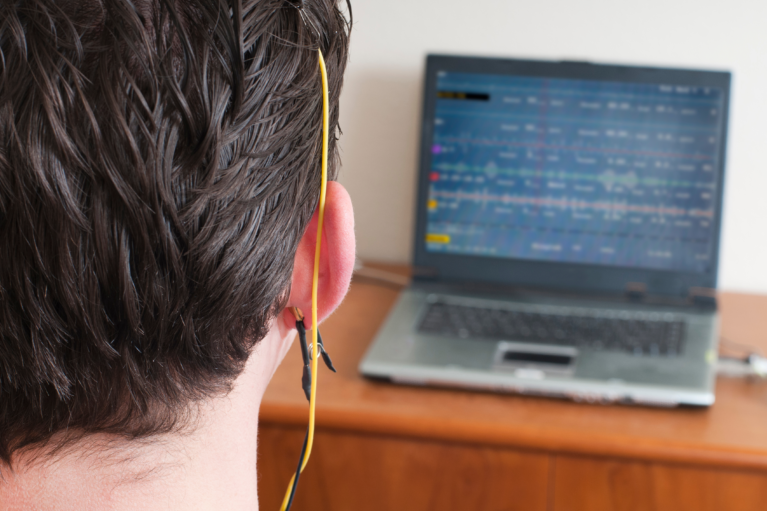Neurofeedback Therapy in Watkinsville & Athens
Neurofeedback therapy, in simple terms, is a non-invasive way of training brainwaves to stay within normal patterns. With a qualitative electroencephalograph (QEEG), aka – brain mapping, abnormalities in a patient’s brainwaves can be detected. With this information we can then create custom brain training protocols and use the process of neurofeedback therapy to help realign or retrain these frequency signals. Through this, specific regions of the brain can be retrained, allowing each one to work together so that the brain can function at its best.
Neurofeedback therapy is an alternative to addressing brain based issues without medication. Many people opt for this kind of therapy to avoid building a dependence on medication. Though the concept of realigning one’s brainwaves may seem intimidating to some, neurofeedback therapy has been researched since the 1960s, beginning with Dr. Joe Kamiya and Dr. Barry Sterman. They based their research regarding neurofeedback therapy on an earlier discovery by the German physicist Hans Berger. Between 1929 and 1938, Berger published a series of articles that showed how brainwaves, which are caused by brain neurons, can be recorded and measured.
Request an Appointment
EEG (Brain Training) – Uses and Clinical Application
One of the more well-known benefits of neurofeedback therapy is that it can help address the following types of issues, where misaligned brainwaves that are not working together harmoniously have the possibility of being an underlying component of these issues:
- ADHD & OCD
- Depression & Anxiety
- Insomnia & Stress
- Chronic Pain & Brain Injury
- Addictions & Dependencies
- Autism Spectrum Disorder
- Epilepsy & Seizures
- Fibromyalgia
- Migraines & Headaches
- Learning Disabilities
- PTSD & Trauma
Brainwave Types
Similar to radio signals or frequencies, the brain also produces a variety of brainwave types, these include the following six primary ones:’
- Delta: These are the slowest of brainwaves that are typically associated with the third and fourth stages of sleep. Manipulating delta brainwaves can help address headaches, traumatic brain injury, learning disorders, sleep problems, and sharp and hard muscle contractions. Through this, you can experience reduced pain, increased comfort, and better sleep.
- Theta: These brainwaves involve emotion, memory, sleep, creativity, hypnosis, and meditation. In terms of sleep, theta brainwaves are associated with the first stage of sleep, when it is light. Manipulating the theta brainwaves can help address depression, anxiety, emotional disorders, distractibility, and ADHD.
- Alpha: Alpha brainwaves typically relate to a calm and pleasant situation or alertness during a relaxed state. During meditation, alpha waves are seen to increase. They also describe the creative activity of the brain during relaxation, which can eventually lead to sleep. Realigning alpha brainwaves can result in pain relief, natural stress relief and reduced anxiety, improved mental performance, and the healing of brain injuries.
- Beta: Beta brainwaves denote mental performance such as the ability to focus, solve problems, and exercise conscious precision. Thus, realigning beta brainwaves can help cognitive processes and address disorders such as ADHD, depression, insomnia, OCD, and alcoholism.
- SMR: Sensorimotor rhythm (SMR) frequencies are related to mental alertness and physical relaxation.
- Gamma: These brainwaves have the highest frequency and are often related to memory and cognitive processing. Thus, training gamma brainwaves can help organize the brain, enhance the speed of information processing, promote cognition, improve mental sharpness, and promote faster problem-solving.

Neurofeedback
What to Expect
At the beginning of your treatment, quantitative EEG (qEEG) will map out your brain and determine which regions are out of alignment. This sets the baseline information that will tailor your neurofeedback therapy sessions to address specific regions of the brain that need attention. As mentioned, you will have sensors attached to your scalp to then monitor these misaligned brainwaves while you watch a movie or listen to audio. Depending on your issues, neurofeedback therapy may take an average of 30 to 40 sessions that last around 30 minutes each. Some patients may notice immediate changes while others might take more time. However, for this to be more effective, it is recommended for patients to continue going to sessions until it is deemed complete. Age is also a factor when it comes to the effectiveness of neurofeedback therapy. Dr. Cook takes a holistic approach to health. In addition to helping those seeking to change their mental health, Chiropractic Works offers nutrition consulting & lifestyle coaching services to effectively address your entire well being. Book Appointment
How Does Neurofeedback Therapy Work?
Brain Training
As a non-invasive process, neurofeedback therapy works by having sensors attached to your scalp using conductive paste. Functioning like small microphones, these sensors can record and amplify brainwave activities being produced. Unlike shock therapy, neurofeedback therapy does not create electricity, neither does it read thoughts. It simply proffers a reward once the brain creates normal patterns when you watch or listen to a video or audio of your choice. By watching or listening, the sensors pick up cues, then transform the images on the screen and tones. Through neurofeedback therapy, the brainwaves in specific regions can be examined, which helps determine which ones are out of alignment. The process works to improve this by implementing brain training to align its brainwaves. An example is when the video pauses, triggering the brain to subconsciously modify its patterns. Through repetition, the brain gradually learns how to stay within healthy patterns. Book AppointmentFrequently Asked Questions About Neurofeedback
Neurofeedback therapy will only be effective if you get a practitioner who is certified to practice this technique. Sessions must also be completed so that you can experience the intended effects.
Neurofeedback requires a doctor who is a licensed professional and equipment designed for receiving and reading brainwaves, so patients must engage in sessions at the doctor’s practice.
Neurofeedback is not normally covered by insurance companies, but Chiropractic Works offers payment plans to help with expenses.
Most neurofeedback therapy sessions last for about 30 minutes. On average, it can take about 30 to 40 sessions. However, an individual’s condition may necessitate more sessions for optimum results.
There are various research materials and studies proving the efficacy of neurofeedback therapy when it comes to managing anxiety. By regulating certain brain waves related to anxiety, such as the alpha or theta brainwaves, through training you will be able to better manage these types of issues.
This will depend largely on your condition and our initial findings. At the beginning of your treatment, a QEEG (Quantitative Electroencephalogram is used to measure the dysregulated brain waves, which will determine which regions of your brain need realignment. This information will help determine how many sessions you will need and how long each one will take.
This is a great question and one we get often. Technically you could train your brain every day if you were so inclined and results with this are fantastic. We recommend most people shoot for about a three times per week training schedule until the protocol is complete. We definitely suggest no less than two times per week. Additionally, there will be some simple home passive training exercises for you to do on days where you are not in the office actively training. Training any less than this will really not be of any benefit. Think about it, if you went to the gym once per week to do an exercise, how long do you think it will be before you realize any benefits from that exercise?
Ideally, over the course of training you will start to see/feel subtle improvements with your particular issues with each neurofeedback therapy session. Issues can be spotted right away before they escalate into bigger problems. Oftentimes friends and family may start to see hints of these changes even before you feel or notice them yourself. Sometimes it may even just feel like an overall sense of improved wellness. However, most importantly, throughout your training protocols there will be at least two different times where we will remap the brain with another qEEG. This information then will be compared directly with the previous results and we will have metrics demonstrating objective changes with the brainwave frequencies. Occasionally some people have a hard time personally noting some of these changes and with that it is always recommended to complete sessions for best results.
A certified, trained, and trustworthy practitioner with the right equipment is the best candidate to provide neurofeedback therapy. They should be able to complete a qEEG assessment before the training sessions begin and are knowledgeable about accurately identifying abnormal brainwaves. A well-trained practitioner should also know which regions of the brain should be targeted for best results, as well as be able to place sensors in their proper locations.
Neurofeedback primarily deals with brainwaves, while biofeedback is more of an umbrella term that describes any type of feedback training where bodily functions are monitored by medical equipment. Some examples of this equipment include a thermometer, blood pressure cuff, or PET scan. That said, neurofeedback is classified as a type of biofeedback.
Neurofeedback is not harmful and is a very safe and effective therapeutic modality. Versus side effects, it is more typical that we say neurofeedback has side benefits because quite often, there are other realized positive changes that come along with improving the initial concerns and issues. Neurofeedback can be successful nearly 80% of the time.
Contact Chiropractic Works for Neurofeedback Therapy Today
Since the 1970s, there have been thousands of studies published in peer-reviewed journals proving the effectiveness of neurofeedback therapy. Many of these articles focused on how neurofeedback therapy improved brainwaves by training a patient’s brain to produce a specific brainwave. Further studies have also seen the effectiveness of neurofeedback therapy on neurological disorders, as well as enhancing an individual’s performance at school or work. Such is the efficacy of neurofeedback therapy that it has been approved by the FDA and is used by NASA in training programs with the objective of enhancing a pilot’s ability to concentrate during highly stressful situations.

